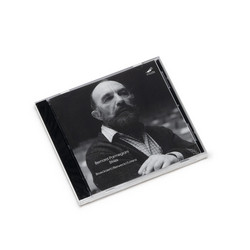Bernard Parmegiani - Stries
Founded in 1984, with a catalog defined by fantastic recordings of works by John Cage, Morton Feldman, Giacinto Scelsi, Morton Subotnick, Joan La Barbara, Steve Reich, Pauline Oliveros, Alvin Lucier, Luc Ferrari, Phill Niblock, Iannis Xenakis, James Tenney, and dozens of others - currently sprawling into the multiple hundreds - the New York based imprint, Mode Records, stands among the most important initiatives within the landscape of experimental music. In addition to their remarkable dedication to sustaining historical artists and archival recordings, Mode gains particular distinction for their releases of new renderings, by contemporary ensembles, of neglected works by major composers. Their latest, the first ever release of the French electroacoustic pioneer Bernard Parmegiani’s astounding work for tape and three synthesizers, Stries, composed in 1980 and almost entirely unheard since, is one such case. Recorded at Groupe de Recherches Musicales (GRM) by Colette Broeckaert, Martin Lorenz, and Sebastian Berweck, with the close collaboration of Yann Geslin - member of the Paris-based electroacoustic trio, TM+, for whom the work was composed - it’s absolutely incredible and easily one of the most exciting and important Parmegiani releases to have emerged in recent years.
Bernard Parmegiani’s name towers within the field of electronic and electroacoustic music. He was an artist of rare vision, whose work rode the razor’s edge between radical singularity and playful humor, for whom recognition came late, largely due to his dedication of live, real time realizations of his work - leaving a relatively small output of recorded releases during his lifetime - and to composing for film, television, and theatre.
Parmegiani, who passed away in 2013, was a fascinating figure. Initially a student of theatre and mime, he shifted toward music during the 1950s, becoming one of the first students to study under Pierre Schaeffer at Groupe de Recherches Musicales (GRM), shortly after its founding, before joining the studio and collective’s ranks as a full-fledged member and going on to create, over the next half a century, one of the most important and visionary bodies of electroacoustic music in history. Parmegiani's use of concrete, electronic, electroacoustic, and Acousmatic techniques, was not only remarkably diverse - spanning numerous contexts and applications, but it was vast and second to none.
In 1980, Parmegiani composed the work, Stries, for the Paris-based electroacoustic trio TM+ - Yann Geslin, Laurent Cuniot and Denis Dufour - founded at the GRM in 1977 to explore the relationships between electronic and acoustic instruments during live concert settings. Notably absent from the expansive Parmegiani 12 CD retrospective, L’œuvre Musicale, and only released in partial form on the TM+ release, Trio Instrumental Électroacoustique, issued by INA-GRM in 1984, it has not been performed live for more than 30 years and stands among the most overlooked of the composer’s important works.
Embarking on the monumental task of recording this epic, 45-minute work, the trio Broeckaert//Berweck//Lorenz, entered into close collaboration with Yann Geslin, one of the members of TM+ who had originally realized the work, and meticulously reconstructing Parmegiani’s patches from the original score on a series of vintage and contemporary synths, seeking to render it to the composer’s meticulous vision. The result is nothing short of staggering, bringing a truly astounding, lost work in its complete form, alive before our ears.
Composed in three movements, Stries was based on the tapes of Parmegiani’s Violostries for violin & tape from 1963, with its tape component - defining the first section, Strilento, derived completely from recordings of the violin which Parmegiani masterfully alters to create an at times extremely dense, at other times pointillist, piece of music. A masterful illumination of the transformative potential of electronic process on acoustic sound sources - bubbling with tension and complex structure - the work gets off to a mind-blowing start, before moving to the following two sections - Strio and Stries - that deploy the tape material in very different terms against the synthesizers yielded with dexterous skill by Broeckaert//Berweck//Lorenz.
Imagistic and almost narrative in scope - first playing long, minimal harmonic tones against the delicate textural tape elements, before all four actors join in a truly astounding dance of rippling punctuation and sweeping synth lines - Stries is a true wonder of electroacoustic composition. It boggles the mind how it has remained outside the recognized canon of Parmegiani’s major works for so long. Easily one of the best electronic works that has passed before our ears in many years, Mode has knocked it out of the park with this one. Engrossing from start to finish and leaving you desperate for more, not to mention as historically important as they come, it’s impossible to recommend enough. Broeckaert//Berweck//Lorenz have done a masterful job bringing this towering work back to life. Issued on CD, complete with fantastic liner notes by Sebastian Berweck, detailing the full process of reconstructing, recording, and performing the work, it’s an absolute must for any fan of electronic music, Parmegiani, or GRM..

